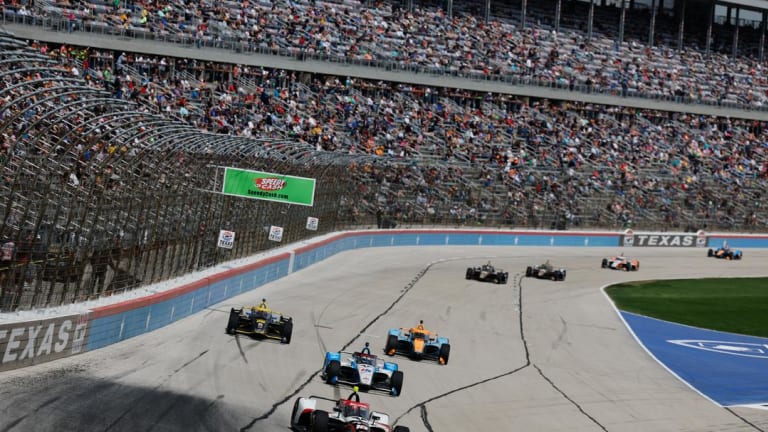
After the great race at Texas, can the Indianapolis 500 get here tomorrow?

After two hours of NTT IndyCar Series bliss on Sunday at Texas Motor Speedway, where Josef Newgarden won a race reminiscent of the series’ best events, I yearn for more oval-track racing.
Too bad we’ll have to wait until the 500 on May 28.
Nothing against the streets of Long Beach, the rolling hills of Barber Motorsports Park or the twists and turns around the Pagoda on the Indianapolis Motor Speedway road course, where IndyCar will race its next three rounds before the 500.
But oval racing is the foundation of this series, where it produces much of its best work, where the sheer speed and skill on display sets itself apart from that other open-wheel series (you know, the one that Generation Netflix is convinced is all that exists).
Sunday’s race on Texas’ 1.5-mile D-shaped layout stated a perfect case for scheduling more races on oval tracks, which may have surprised some people because recent IndyCar races there haven’t been nearly this good.
Two years ago, nobody dared move out of the bottom groove because the sticky substance applied higher in the turns to help NASCAR didn’t agree with Indy cars. Last year, with an extra practice session devoted to rubber in the second lane, the IndyCar race was better; maybe a lane and a half was race-able, which helped Newgarden pass teammate Scott McLaughlin in the final turn to win.
Another practice was devoted to improving the outer lane this year. But more important, apparently, were aero pieces that teams could use on the underside of the cars to help stability in the corners.
Whatever the reason, it created a level of on-track intensity that IndyCar can use to market the sport to new fans.
And it happened on an oval.
I know IndyCar would love to race more on ovals – there are only five races on four ovals this year -- but it’s not a simple endeavor. In this game, it takes much more than two to tango, with promotional commitment, TV windows, sponsor whims and logistics beyond anything we might imagine needed to pull off a successful event.
If the race at Texas, with aero tweaks to the cars and a track surface well-suited to passing, can be replicated at other ovals, it would be foolish not to look into the possibilities.
Besides Newgarden, nobody should have smiled more than the crew from VICE Media Group, which has been gathering material for the six-part series “100 Days to Indy,” which will air on the CW Network beginning April 27. If they hoped to capture the speed, danger, talent and personality that define IndyCar, the Texas race could have been a six-part series on its own.
There were 26 lead changes among eight drivers and 1,070 on-track passes in the 250-lap race, much of it happening at 220 mph. Even the so-called boring moments of the race, if that’s possible at these speeds, kept your attention.
Oval racing at Texas made tire management dramatic and fuel-saving intriguing. It made in/out laps feel sexy, and helped us learn how long we can hold our breath.
This isn’t a plea for the pack racing of the early 2000s. But what we saw Sunday was a pretty close cousin.
The racing was sidepod-to-sidepod and nose-to-tail in the frantic laps after restarts when tires were fresh and nobody was concerned with hitting a fuel number.
It was marvelous.
In the final 20 laps, Pato O’Ward led Newgarden, then Newgarden led O’Ward, then Alex Palou stuck his nose into the fray and took the lead, with a half-dozen others close behind.
The race wasn’t decided until a late crash -- when Romain Grosjean hit the wall with two laps remaining -- froze the field with Newgarden narrowly ahead of O’Ward.
For the first time in a couple of hours, everyone could relax.
Dangerous? You bet. The pucker factor hits max level with racing this close, and there are no soft hits when something goes wrong at more than 200 mph.
Graham Rahal took a frightening ride when his car ramped over Devlin DeFrancesco and nosed into the Turn 3 barrier. Sting Ray Robb crushed the inside barrier down the back straight. Grosjean, Felix Rosenqvist, Kyle Kirkwood and Takuma Sato also crashed, but thankfully the greatest injury was likely the crash damage to their teams.
This is such a safe era for IndyCar – thanks to the aeroscreen, advances in energy-absorbing materials on the Dallara race cars and, above all, the SAFER Barrier – that maybe this almost-but-not-quite pack racing can work.
Go ahead and yearn for Milwaukee, Kentucky, Phoenix, Richmond, Nashville and Homestead, because I am. Granted, those ovals won’t produce the near-pack racing experience of a higher-banked track like Texas, but they will provide balance to a schedule that’s way too heavy with street and road course races.
Yep, no doubt about it, I can’t wait for the Indy 500.